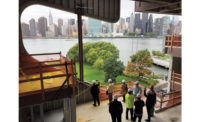In January, Minneapolis-based Cuningham Group Architecture submitted a proposal for a public elementary school in Austin, Texas. It expected to be one of ten competing firms, says firm principal Tim Dufault, AIA; instead, it was one of two dozen. Similarly, it expected little competition for an elementary school in suburban Albuquerque—a project that ultimately drew 32 proposals.
Traditionally, public schools are not the most sought after commissions, due to low budgets and little room for unique designs. That so many firms are now pursuing these types of commissions reflects a hard reality: the public realm is one of the only sectors with a pulse right now.
The Architectural Billings Index, a leading economic indicator, has fallen below 50 for 14 straight months, hitting 33.3 in January, a record low. According to Kermit Baker, the AIA's chief economist, the inability to get financing for construction projects has led to poor business conditions among design firms overall. "Obviously, more firms are looking to diversify their offerings,” Baker says, “and it's resulting in more firms competing for the same projects."
Jeanne Jackson, AIA, of Salt Lake City-based VCBO Architects—one of Utah's largest firms specializing in public schools—says her work has traditionally been unaffected by the economy. “But it appears that firms who have done few school construction projects are now starting to throw their hats in the ring, presumably because the market is tighter,” she says. And though these commissions usually go to local architects, Jackson says she has seen many firms trying to get a “leg up” on the competition by teaming up with out-of-state “experts” on a particular type of building.
Some architects say they aren’t concerned about the increased competition because they already have strong relationships with school districts. “Really, it all depends on the firm’s relationship with the client," says John Weekes, AIA, of Portland, Oregon's Dull Olson Weekes, one of few design firms that is actually hiring right now. Dufault adds that regardless of recent trends public schools are “still a very locally dominated market.”
While demand for schools is strong, there is plenty of uncertainty about funding. Dufault and Jackson have both seen new public projects getting delayed, especially schools, which typically are paid for through a bond process. Jackson says many districts aren’t even entertaining the idea of new construction because they fear their constituents won’t pass bond measures. Federal stimulus dollars could provide a shot in the arm for school districts: More than half of the $53.6 billion State Fiscal Stabilization Fund was earmarked for education, part of which could be used for school renovations or construction.
Even if the economy picks up, many expect competition for public schools to remain high. Dufault sees this as a good thing, as it will put architecture front-and-center at school board meetings and stimulate a conversation about design. "Great architecture," Dufault says, "only happens when the community values design and commits to invest in it."
Read more economic news in our Recession and Recovery special section.



Post a comment to this article
Report Abusive Comment